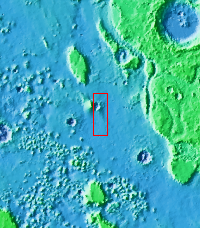
|
Not Round Crater
- Click the image above for a larger view
- Full-Res JPEG (1367 x 2922) (322.2 kB)
- Full-Res TIFF (1367 x 2922) (4.0 MB)
Caption:
Most impact events create round craters. In this case the crater is not round, which likely means the surface had fractures or preexisting tectonic features that diverted some of the impact stresses along those features and resulted in the straighter east and north sides.
Orbit Number: 46152 Latitude: 10.6203 Longitude: 323.397 Instrument: VIS Captured: 2012-05-10 09:25
Background Info:
Please see the THEMIS Data Citation Note for details on crediting THEMIS images.
NASA's Jet Propulsion Laboratory manages the 2001 Mars Odyssey mission for NASA's Science Mission Directorate, Washington, D.C. The Thermal Emission Imaging System (THEMIS) was developed by Arizona State University, Tempe, in collaboration with Raytheon Santa Barbara Remote Sensing. The THEMIS investigation is led by Dr. Philip Christensen at Arizona State University. Lockheed Martin Astronautics, Denver, is the prime contractor for the Odyssey project, and developed and built the orbiter. Mission operations are conducted jointly from Lockheed Martin and from JPL, a division of the California Institute of Technology in Pasadena.
Cataloging Keywords:
| Name | Value | Additional Values |
|---|---|---|
| Target | Mars | |
| System | ||
| Target Type | Planet | |
| Mission | 2001 Mars Odyssey | |
| Instrument Host | Mars Odyssey | |
| Host Type | Orbiter | |
| Instrument | Thermal Emission Imaging System (THEMIS) | |
| Detector | ||
| Extra Keywords | Crater, Grayscale, Impact, Thermal | |
| Acquisition Date | ||
| Release Date | 2012-08-07 | |
| Date in Caption | 2012-05-10 | |
| Image Credit | NASA/JPL/ASU | |
| Source | photojournal.jpl.nasa.gov/catalog/PIA15916 | |
| Identifier | PIA15916 | |

